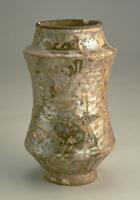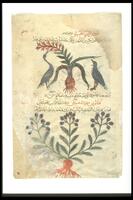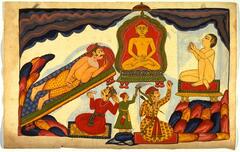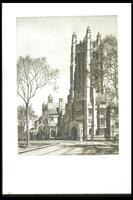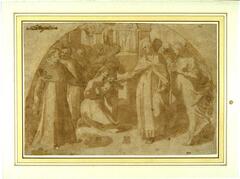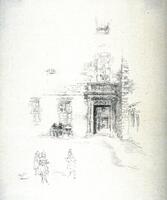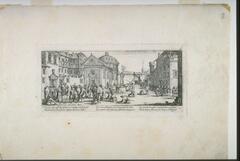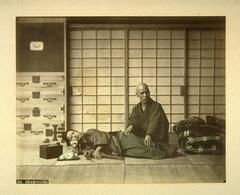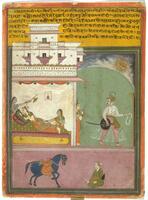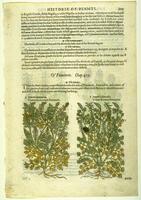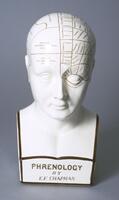11 Items in this Learning Collection
Collection Object
Collection Object
Collection Object
Collection Object
Collection Object
Resource with 0 media
Collection with 8 items
Resource with 0 media
Collection Object
Collection Object
Copyright
All Rights Reserved
()
Digambara Jain manuscript page: Jina and devotees
Accession Number
1975/2.176
Title
Digambara Jain manuscript page: Jina and devotees
Artist(s)
Artist Unknown, India, Rajasthan, Sirohi School
Object Creation Date
circa 18th century
Medium & Support
ink, opaque watercolor, and gold on paper
Dimensions
7 1/4 in x 11 7/16 in (18.4 cm x 29 cm);7 1/4 in x 11 7/16 in (18.4 cm x 29 cm)
Credit Line
Gift of Dr. and Mrs. Leo S. Figiel and Dr. and Mrs. Steven J. Figiel.
Label copy
Gallery Rotation Spring/Summer 2012
Jina and devotees from Digambara Jain manuscript
India, Rajasthan, Sirohi School
circa 18th century
Ink, opaque watercolor, and gold on paper
Gift of Dr. and Mrs. Leo S. Figiel and Dr. and Mrs. Steven J. Figiel, 1975/2.176
Jains highly revere the written word—one day of the liturgical year is even set aside to worship texts—and before the era of the printed book it was customary for a lay donor to commission a handwritten manuscript for presentation to a spiritual teacher and ultimately to the temple library. Indeed arranging for manuscripts to be copied for monks to use was expected of the laity as part of their support for and devotion to the monastic community. Monks and nuns were themselves discouraged from practicing the art of painting: one text expressly warns of the power of painting to arouse sensual feelings. Beholding a book, however, was believed to help the individual achieve the proper mental state for spiritual guidance.
In these colorful pages, the golden-hued Jinas (or enlightened Jain teachers) and the monks who venerate them are nude, identifying them as belonging to the Digambara (sky-clad) sect of Jainism. In the page on the right a figure is reclining, its belly visibly swollen. The verse that originally accompanied the image was about dropsy, more commonly known as edema. It says, “Those who have been utterly wrecked by their burdensome, swollen abdomens, who are plagued by the terrible disease of dropsy and have given up all hope, become as handsome as the god of Love himself, their bodies anointed with a life-saving nectar, the dust from your lotus feet.” Reciting this verse in prayer to the Jina was supposed to bring relief from this unbearable disease.
The page on the left praises the divine drum that resounds when the Jina achieves Enlightenment, proclaiming the greatness of his teaching. In the upper register we see the Jina seated in meditation with the naked monk Manatuga at his side. In the lower register two gods beat kettle drums, while a third dances and beats a tambourine.
Subject matter
In the Jain religion, book production reflects the integral relationship among the laity, monastic community, and the Jina, or enlightened Jain teacher. The dedication of sacred books for shrines is required of devotees, while commissioning a book fulfills the lay obligation of charity, and beholding a book helps the individual achieve the proper mental state for spiritual guidance. It was customary for a lay donor to commission a copy of a text for presentation to his spiritual teacher and ultimately to the temple library. Over the centuries, monastic libraries received great quantities of texts, which were employed in the instruction of monks and nuns, themselves discouraged from practicing the art of painting: one text expressly warns of the power of painting to arouse sensual feelings.
In these colorful pages, the golden-hued Jinas and the monks who venerate them are nude, identifying them as belonging to the Digambara (sky-clad) sect of Jainism. A central concern of many medieval hymns and rituals is curing disease with many of the verses promising relief from sickness. The verse that originally accompanied the page on the right was about dropsy, more commonly known as edema. The patient is reclining, belly visibly swollen. The verse tells us, “Those who have been utterly wrecked by their burdensome, swollen abdomens, who are plagued by the terrible disease of dropsy and have given up all hope, become as handsome as the god of Love himself, their bodies anointed with a life-saving nectar, the dust from your lotus feet.” Reciting this verse in prayer to the Jina brings relief from this unendurable disease.
The page on the left praises the divine drum that resounds on the Enlightenment of the Jina, proclaiming the greatness of his teaching. We see in the upper register the Jina seated in meditation with the naked monk Manatuga at his side. In the lower register two gods beat kettle drums, while a third god dances and beats a tambourine.
Physical Description
Multi-colored ink on paper. Prominent reds, yellows and blues. Six figures, three smaller (clothed), three larger (nude or semi-nude). Scene of worship.
Primary Object Classification
Painting
Additional Object Classification(s)
Unbound Work
Collection Area
Asian
Rights
If you are interested in using an image for a publication, please visit http://umma.umich.edu/request-image for more information and to fill out the online Image Rights and Reproductions Request Form.
Keywords
album leaf
arrows
figures (representations)
illness
manuscripts
nudes (representations)
painting
reclining
sitting
torches (lighting devices)
1975/2.176
Title
Digambara Jain manuscript page: Jina and devotees
Artist(s)
Artist Unknown, India, Rajasthan, Sirohi School
Object Creation Date
circa 18th century
Medium & Support
ink, opaque watercolor, and gold on paper
Dimensions
7 1/4 in x 11 7/16 in (18.4 cm x 29 cm);7 1/4 in x 11 7/16 in (18.4 cm x 29 cm)
Credit Line
Gift of Dr. and Mrs. Leo S. Figiel and Dr. and Mrs. Steven J. Figiel.
Label copy
Gallery Rotation Spring/Summer 2012
Jina and devotees from Digambara Jain manuscript
India, Rajasthan, Sirohi School
circa 18th century
Ink, opaque watercolor, and gold on paper
Gift of Dr. and Mrs. Leo S. Figiel and Dr. and Mrs. Steven J. Figiel, 1975/2.176
Jains highly revere the written word—one day of the liturgical year is even set aside to worship texts—and before the era of the printed book it was customary for a lay donor to commission a handwritten manuscript for presentation to a spiritual teacher and ultimately to the temple library. Indeed arranging for manuscripts to be copied for monks to use was expected of the laity as part of their support for and devotion to the monastic community. Monks and nuns were themselves discouraged from practicing the art of painting: one text expressly warns of the power of painting to arouse sensual feelings. Beholding a book, however, was believed to help the individual achieve the proper mental state for spiritual guidance.
In these colorful pages, the golden-hued Jinas (or enlightened Jain teachers) and the monks who venerate them are nude, identifying them as belonging to the Digambara (sky-clad) sect of Jainism. In the page on the right a figure is reclining, its belly visibly swollen. The verse that originally accompanied the image was about dropsy, more commonly known as edema. It says, “Those who have been utterly wrecked by their burdensome, swollen abdomens, who are plagued by the terrible disease of dropsy and have given up all hope, become as handsome as the god of Love himself, their bodies anointed with a life-saving nectar, the dust from your lotus feet.” Reciting this verse in prayer to the Jina was supposed to bring relief from this unbearable disease.
The page on the left praises the divine drum that resounds when the Jina achieves Enlightenment, proclaiming the greatness of his teaching. In the upper register we see the Jina seated in meditation with the naked monk Manatuga at his side. In the lower register two gods beat kettle drums, while a third dances and beats a tambourine.
Subject matter
In the Jain religion, book production reflects the integral relationship among the laity, monastic community, and the Jina, or enlightened Jain teacher. The dedication of sacred books for shrines is required of devotees, while commissioning a book fulfills the lay obligation of charity, and beholding a book helps the individual achieve the proper mental state for spiritual guidance. It was customary for a lay donor to commission a copy of a text for presentation to his spiritual teacher and ultimately to the temple library. Over the centuries, monastic libraries received great quantities of texts, which were employed in the instruction of monks and nuns, themselves discouraged from practicing the art of painting: one text expressly warns of the power of painting to arouse sensual feelings.
In these colorful pages, the golden-hued Jinas and the monks who venerate them are nude, identifying them as belonging to the Digambara (sky-clad) sect of Jainism. A central concern of many medieval hymns and rituals is curing disease with many of the verses promising relief from sickness. The verse that originally accompanied the page on the right was about dropsy, more commonly known as edema. The patient is reclining, belly visibly swollen. The verse tells us, “Those who have been utterly wrecked by their burdensome, swollen abdomens, who are plagued by the terrible disease of dropsy and have given up all hope, become as handsome as the god of Love himself, their bodies anointed with a life-saving nectar, the dust from your lotus feet.” Reciting this verse in prayer to the Jina brings relief from this unendurable disease.
The page on the left praises the divine drum that resounds on the Enlightenment of the Jina, proclaiming the greatness of his teaching. We see in the upper register the Jina seated in meditation with the naked monk Manatuga at his side. In the lower register two gods beat kettle drums, while a third god dances and beats a tambourine.
Physical Description
Multi-colored ink on paper. Prominent reds, yellows and blues. Six figures, three smaller (clothed), three larger (nude or semi-nude). Scene of worship.
Primary Object Classification
Painting
Additional Object Classification(s)
Unbound Work
Collection Area
Asian
Rights
If you are interested in using an image for a publication, please visit http://umma.umich.edu/request-image for more information and to fill out the online Image Rights and Reproductions Request Form.
Keywords
album leaf
arrows
figures (representations)
illness
manuscripts
nudes (representations)
painting
reclining
sitting
torches (lighting devices)
